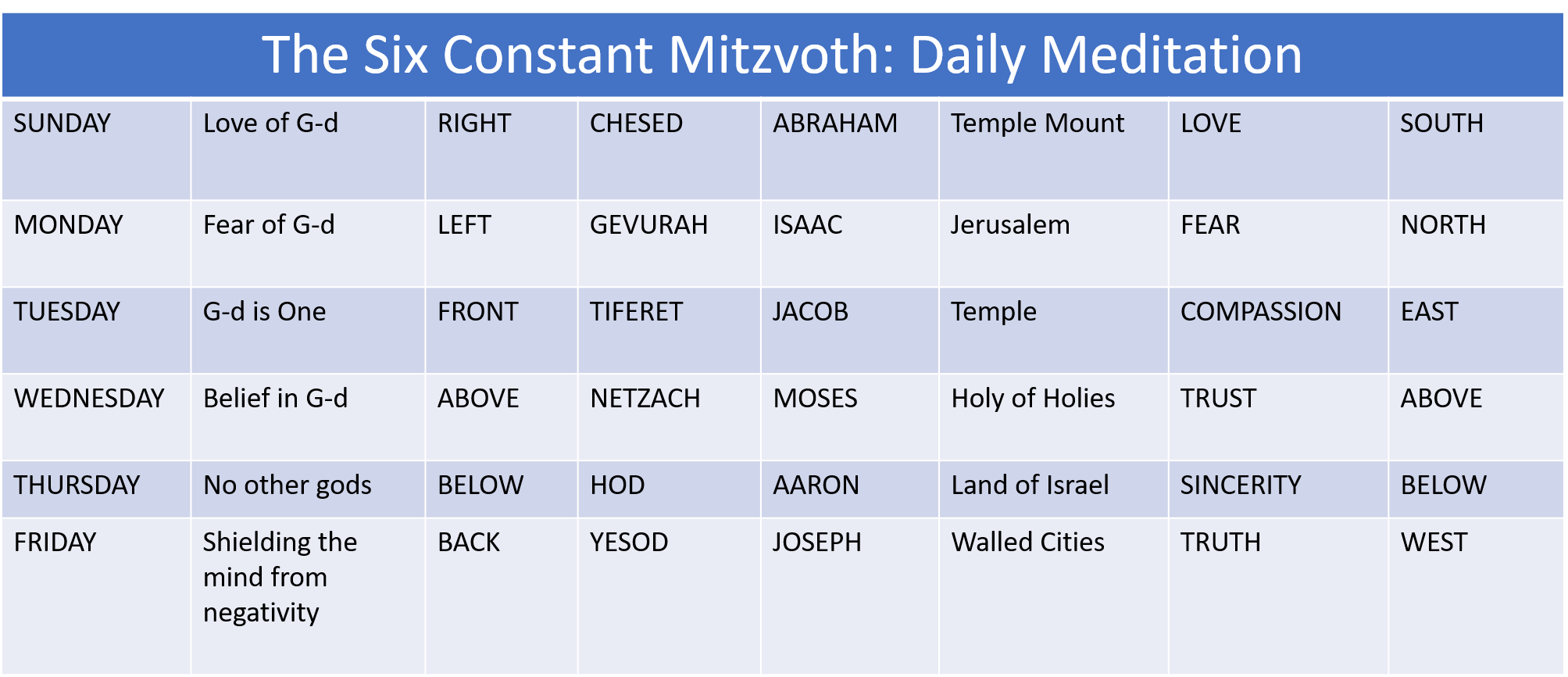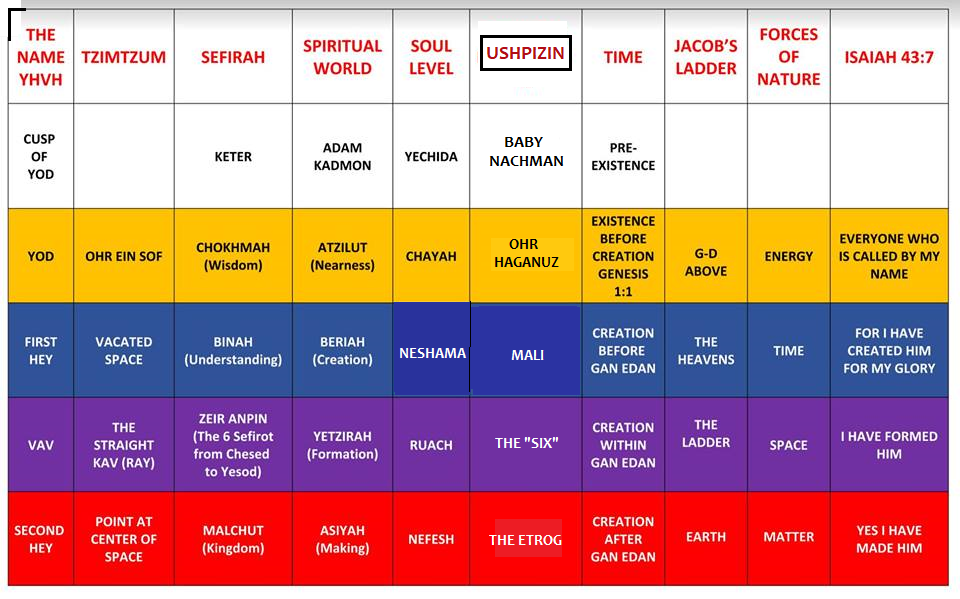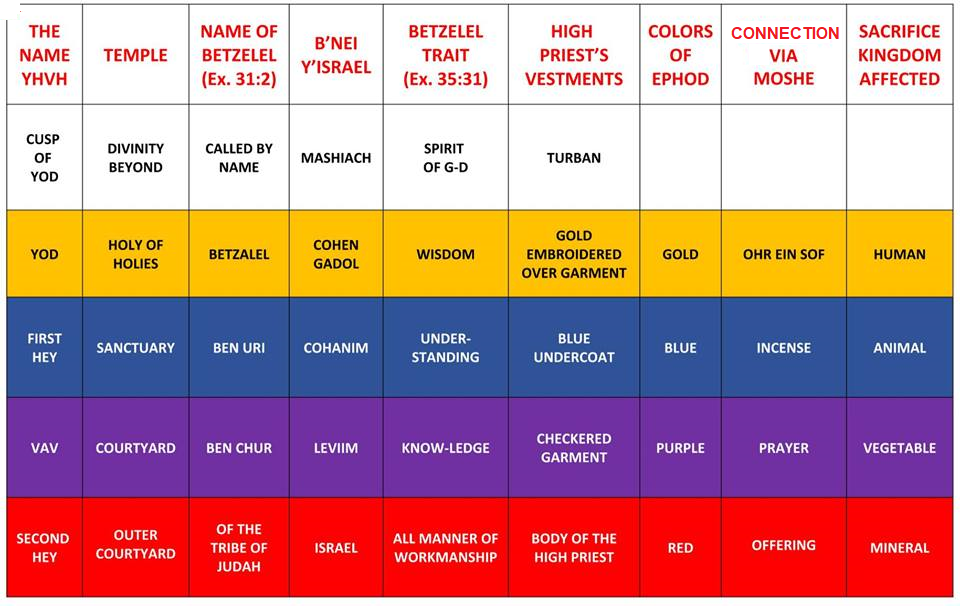The basic idea of a spiritual ‘template’ is something rooted in Torah that presents a ‘path’ of understanding for us to better connect to G-d.
Examples of such templates include:
- The 10 Commandments
- The 4-letter Name of G-d
- The tabernacle/temple design
- Divisions within the people of Israel
- Various Biblical personalities
- Patterns in Biblical verses
“Mapping out” such elements in a chart or a diagram, helps us better understand connections among things that we might not otherwise realize. We can then make use of this connectivity in our own meditative practice.
We previously discussed the relationship between characters in the movie and ideas related to Jewish meditation. Taking those ideas and adding more related concepts, we can create a daily meditation template for the week of Sukkot.*

*Sukkot in 2019 starts on a Sunday night. Adjust accordingly in other years.
The sixth column (headed by Temple Mount) is also part of Rabbi Yitzchak Ginsburgh’s meditation study.) As mentioned in the previous section, the focus on the seventh day is one of incorporating the previous six into our day-to-day routines.
In that previous lesson, we posted this chart, which will now expound upon a bit:

Each of the elements listed across the top of the vertical columns intersects through the horizontal rows. The understanding of the relationship between these things comes primarily from the teachings of Jewish Oral Torah. As mentioned previously, these rows/levels relate to (among other things) the “Spiritual Worlds of Existence” (featured in the 4th column). There are many such concepts that can be placed into this template. Over 100 are found on the 13 Petals Soul Chart.
Examing the particular concepts in the ten columns.
- Column 1: The letters of the 4-letter Name of G-d. In addition, there is a 5th level that relates to the hidden ‘cusp’ of the letter Yod. This “most holy name” is the “trunk of the tree” for all study as everything in existence relates to it and the “Worlds of Existence.”
- Column 2: The process of creation (according to the Ari) where the light of “Ein Sof” caused a constriction (tzimtzum) enabling something “other than Ein Sof” to be. This column begins at Atziut as there is no concept of tzimtzum at the level of Ein Sof.
- Column 3: Though all ten Sefirot exist within each world, there is also a special relationship between the worlds and specific Sefirot.
- Column 4: The worlds of existence. The bottom three rows are the 3 worlds within creation. The gold fourth row is the idea of existence prior to creation. The top white fifth row is that of singularity and “pre-existence.”
- Column 5: The corresponding “levels of the soul” as commonly understood in Judaism. Most people only ‘deal with’ the lower three in this life. The Nefesh is the basic soul that is active in all humans. The level of Ruach is that of contemplating spiritual matters. The nevel of Neshamah is that of making a ‘connection’ to true spirituality.
- Column 6: The characters/elements from the Ushpizin movie.
- Column 7: How ‘existence’ is viewed with regard to the ‘timeline’ of the creation story. The Torah begins with the letter Beit, the second letter of the Hebrew Aleph-Beit, which ‘hints’ that there is “something before” existence. The first four words in Genesis, mentioning the Creator (Elohim), are “within existence but prior to creation.” The figure of ‘Adam’ before Gan Edan is very conceptual. Adam is ‘divided’ into both Adam and Chavah in the Garden. Lastly they become ‘physical’ entities (like us) upon exiting it.
- Column 8: The Worlds of Existence as they present in Jacob’s ladder dream. The dream does not directly address beyond Atzilut.
- Column 9: Forces of nature as they relate to the 4 Worlds of Existence.
- Column 10: A verse from Isaiah that reflects the 4 Worlds of Existence.
Let’s add the Ushpizin elements to some other concepts from the ‘master chart’ at 13 Petals Soul Chart.” Here we selected a variety things in terms of how we relate to G-d, such as prayer, study, how we think, etc.

In this next template. aspects of the priesthood, tabernacle and temple are the focus. (We’ve left off the Ushpizin column as it can be referenced in the above charts.)

